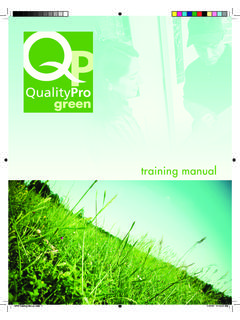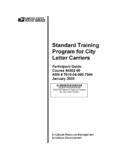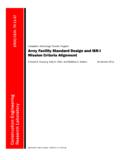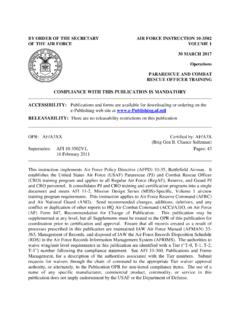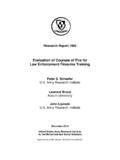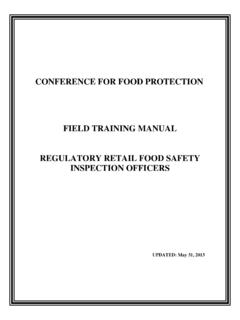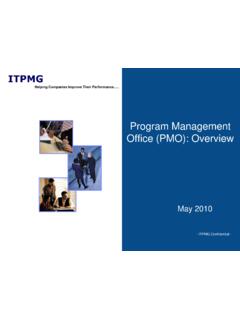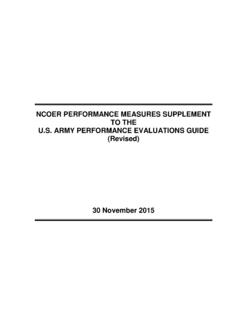Transcription of 2013 Pest Management Standards For Food Plants
1 2013 Pest Management Standards For food Plants i INTRODUCTION. T. he National Pest Management Association is pleased to release the 2013 Pest Manage- ment Standards for food Plants . Since 2007, these Standards have been the cornerstone of NPMA's Commercial Division activities. Of note in the 2013 revision is the move away from prescriptive instructions regarding place- ment and monitoring frequency of pest Management devices. Instead, a more results-oriented approach to pest Management , based on pest trends, inspection observations, and professional knowledge is embraced.
2 As stated in previous editions, these Standards also do not preempt local, state, provincial, and/. or federal regulations. Any service provided must comply with government regulations or stat- utes governing pest Management , safety, and food protection. In addition, food Plants may have requirements more stringent than these Standards . By embracing these Standards , pest Management firms demonstrate the industry's role as protectors of food and property. In addition to these Standards , a comprehensive online testing site can be found at This website includes the study guide and other resources noted in the Standards .
3 Through this site, NPMA is working to provide the tools neces- sary for pest Management firms to comply with the Standards and raise the level of competency of pest Management professionals servicing food Plants . We hope that you find these Standards to be a beneficial addition to your own company proto- cols and procedures. As protectors of food and property, it is our industry's obligation to exceed expectations and demonstrate our role as a vital component to overall food safety. ii Table of Contents 1 Personnel Employee 2.
4 2. Security and Criminal Background 3. Plant Personnel 3. 4. 4. Minimum Training Standards for 5. Compliance with 6. 2 Pest Management Plan Rodent Program Exterior Property 8. Rodent Program-Interior 8. Rodent Program- Facility 9. Rodent Program- Frequency of 9. Rodent Program-Spacing of Rodent Management 10. Rodent 11. Insect 11. Birds and 13. Weed 14. Pest Management 14. 14. food 15. Quality 15. Annual 15. Annual 16. 3 Communications 18. 4 Recordkeeping and Contracts 20. Labels and Safety Data 20. Pest Sighting 20.
5 Licenses and 20. Service Protocols and Standard Operating 21. Service and Treatment 21. 5 National Organic Program Working in NOP 24. Appendix A Model Pest Management Inspection 26. Appendix B Current Good Manufacturing Practices (US FDA).. 27. iii definitions For definition purposes, Action Threshold means level of pest activity or pest damage that triggers a pest Management response. Company means the pest Management firm. Contact means the food plant contact person. Devices are any equipment used to monitor or control pests including, but not limited to, insect monitors, rodent bait stations, insect light traps, pheromone traps, and rodent Management stations.
6 Employee means pest Management firm employee. Good Manufacturing Practices means the FDA's Current Good Manufacturing Practices in the United States, or equivalent outside of the Pest Management product means any lure, bait, monitoring product, pesticide, or any other formulated material used in performance of pest Management activities. Plant means a food manufacturing facility including associated warehousing and does not include restaurants or other food service facilities. Rodent bait station means any station used for placement of solid rodenticide bait.
7 Rodent Management station means any station used for monitoring or managing rodents. These include mechanical traps, rodent bait stations (see above), and other placed equipment for rodent Management . Technician means the pest Management firm employee providing service. iv Section 1. Personnel 1. SECTION 1: PERSONNEL. 1. SECTION. Employee Identification Reasoning This section sets forth minimum Standards for company employee identification so that the plant has a clear understanding of which personnel are from the pest Management firm to ensure that plant food safety and security are maintained.
8 Standard All employees entering grounds of a food plant shall display photo identification to include: Employee name Employee identification number (if issued by the company). Company name Company phone number Employee photo Date of issue The identification shall be displayed at all times while the employee is on site unless personnel practices set by the plant prohibit such badges. In addition, Plants may require other identification such as visitor badges and the employee must comply at all times with the visitor/.
9 Contractor policies of the plant. Uniforms Reasoning Uniforms are an important part of the plant safety and Standards program. Criteria set are designed to comply with the majority of food plant requirements for uniforms. Standard All employees who perform service work in food Plants shall wear uniforms meeting the plant's current requirements and at least the following criteria: Slip resistant sole shoes (safety toe if required by plant). Socks Long pants Shirt with sleeves (short or long) with company logo or company name Uniform closures shall be in compliance with plant requirements.
10 A clean set of clothing shall be used in Plants if the previous account visited has exposed the clothing to contaminants. These contaminants include but are not limited to chemical, microbiological, or allergens such as peanut products. More stringent requirements may be in place for individual Plants in addition to these Standards and service personnel must comply with those Standards . 2. SECTION 1: PERSONNEL. 1. SECTION. Security and Criminal Background Checks Reasoning Security is a major concern at all food Plants .

